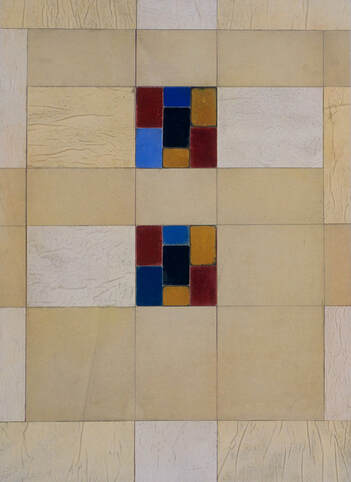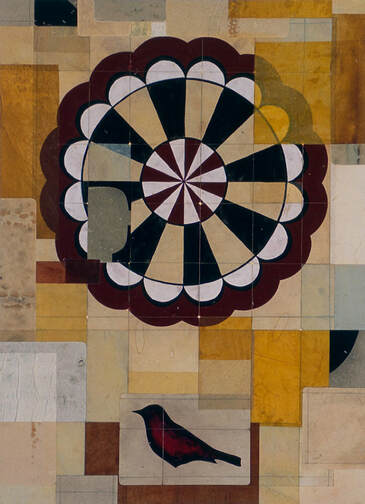Selected Reviews
Andrew Young at Zolla/Lieberman
Art in America, June 2003
- Claire Wolf Krantz
|
Andrew Young’s collages fall into two groups: those that are mainly abstract shapes made of subtly hand-colored papers with simple geometric forms painted on top, and those that, in addition, contain painted images. By rubbing dry ground pigments combined with various binding ingredients into the collaged papers, Young creates rich, flat, variously textured surfaces. On these, he layers a second abstract structure with incised, gridded lines. The abstract pieces glow with a quiet and orderly beauty, and like Mark Rothko’s abstractions, reach toward a vision of eternity that underlies the chaos of experienced reality. Young’s background as the son of a theologian influenced his thinking about art as a vehicle for reflecting on those aspects of the self that are hidden and connected to a spiritual realm.
In my favorite work, Untitled c-253, narrow, beige rectangles frame an inner grid of larger rectangles. In the center are two squares consisting of nine deeply saturated blocks of red, sienna, blue and black. These intense blocks of color become focal points interacting with the quieter areas, all conveying a deep sense of tranquility. |
Place and Formula series (c-253), 2002
Collage of hand-painted papers on museum board 29.5 x 21.5 in. |
|
Caught by Hand series (c-254), 2002
Collage of hand-painted papers on museum board, 30.5 x 22.5 in. |
In other works, Young superimposes a painted layer of invented geometric shapes; flattened, stylized silhouettes of generic birds and insects; or gesturally painted flowers. Compared to the rubbed surfaces, whose luminosity is partly responsible for their numinous associations, the painted areas seem heavier, giving the impression of materiality. In the subtly ambiguous Untitled c-254, a painted mandala-like form grabs center stage. Its concentric arrangement of geometric forms alludes to the unity of existence, while also allowing a more everyday reading as a target. Placed underneath this image is a curiously painted birdlike shape that is missing part of its body and legs. The erasure of these significant elements suggests nature in all its violence, a counterpoint to the cosmic order reflected in the piece’s overall composition.
Other works with multiple images of birds and plants refer to Young’s lifelong interest in the scientific categorizing and ordering of the natural world. Although these are beautiful and conceptually interesting, in the cluttered accumulation they lack the taut drama of the more abstract pieces. In these seemingly simple abstractions, Young has attained a finely turned balance between the spiritual and material orders of being, offering as subject nothing less than the tension of human existence. |

